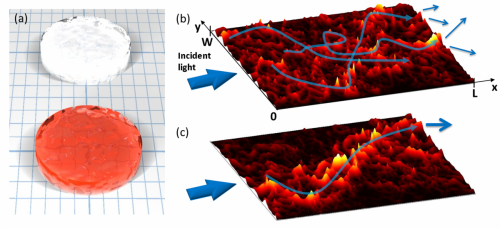Absorption straightens the drunken stagger of light

(Phys.org) —In a study partly funded by the FOM Foundation, physicists from the University of Twente and Yale University have discovered that light travelling through an opaque material follows a straighter path, if the material partially absorbs the light. This insight could be used to improve medical imaging within biological tissue. The researchers published their study on 1 July 2014 in the printed version of Physical Review B.
Light particles travelling through a scattering medium perform a so-called random walk, which resembles an uncoordinated, drunken stagger through the material. The Dutch-American team of researchers has discovered that in opaque media, such as paper, paint or biological tissue, light absorption actually straightens this drunken path. This leads to less diffraction by scattering and so the imaging in opaque materials improves as a consequence of light absorption. This seems counterintuitive: light absorption is usually detrimental for imaging, as it reduces the intensity of the visible image.
From chaotic paths to straight lines
If there is no absorption, light particles (photons) that travel through an opaque medium repeatedly deflect from their straight path due to irregularities in the material. This scattering causes their propagation directions to become randomised. The photons are then difficult to use for imaging, as their original spatial orientation, and therefore the clarity of the image they form together, gradually becomes lost in the material.
Light also behaves like a wave and therefore exhibits wave interference. This means that light waves travelling along different paths can reinforce or extinguish each other. This interference between the long and short paths in the material makes it more difficult to extract information from the transmitted light.
However, if enough light is absorbed, interference is suppressed. In a numerical calculation study, the Twente and Yale scientists noticed that long, meandering light paths are suppressed far more than short straight paths. The result is that with increasing absorption, the straight light paths persist while the number of scattered paths is considerably reduced.
Imaging
This principle can be used to improve imaging through opaque media such as biological tissue. FOM workgroup leader Allard Mosk: "The surprise is that while absorption reduces both the signal and the interference, interference appears to be reduced far more, thereby leaving sufficient signal to image through coloured opaque media."
The results are good news for the lighting industry. Workgroup leader Willem Vos: "Our new insights can be used to achieve much more efficient colour conversion in white LEDs. This reduces the need for precious resources such as rare earth compounds."
The research was supported by the US National Science Foundation, the European Research Council, the Netherlands Organisation for Scientific Research (NWO), the Foundation for Fundamental Research on Matter (FOM) and Technology Foundation STW.
More information: Transmission channels for light in absorbing random media: from diffusive to ballistic-like transport, Physical Review B, Vol. 89, Iss. 25, 1 July 2014. journals.aps.org/prb/abstract/ … 3/PhysRevB.89.224202
Journal information: Physical Review B
Provided by Fundamental Research on Matter (FOM)





















